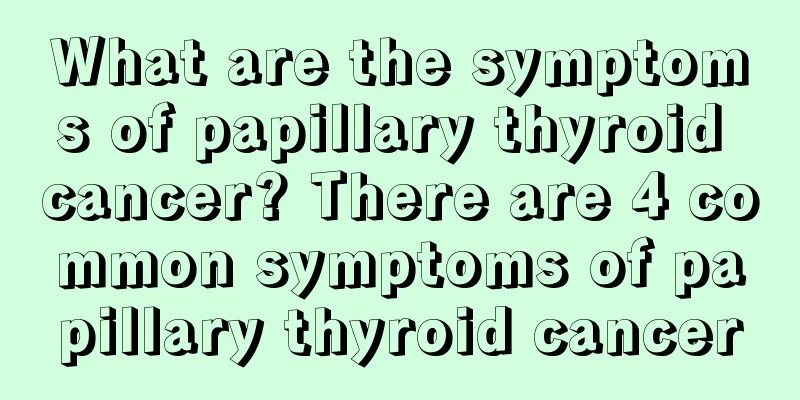What are the symptoms of papillary thyroid cancer? There are 4 common symptoms of papillary thyroid cancer

|
Thyroid cancer is a very common endocrine malignancy that originates from the thyroid epithelial cells. Most of its pathological types are differentiated thyroid cancer, including papillary adenocarcinoma and follicular adenocarcinoma. If differentiated thyroid cancer is treated properly, the prognosis is very good, with a 10-year survival rate of more than 90%. Papillary carcinoma is more common in clinical practice among thyroid cancers. Papillary thyroid cancer is the most common and the least malignant. It accounts for about half of thyroid cancers and is more common in children or young (before 40 years old) female patients. Some patients have undergone neck X-ray treatment in childhood. The tumor grows slowly and can be confined to the thyroid gland for several years. The lesion can spread from the primary site to other parts of the gland and local lymph nodes through the intraglandular lymphatic vessels, or it can be confined for several years, so its nature is easy to be ignored. Symptoms in the middle and late stages 1. Symptoms of local metastasis: In the late stage of thyroid cancer, local metastasis often appears as hard and fixed lymph nodes in the neck. Clinically, papillary thyroid cancer and medullary thyroid cancer are more likely to have metastasis and enlarged lymph nodes in the neck. 2. Local compression symptoms: In the late stage of thyroid cancer, the thyroid tumor continues to swell and may compress the recurrent laryngeal nerve, causing the patient to experience hoarseness, invade the esophagus, cause dysphagia and weight loss, and invade or compress the trachea, causing dyspnea, hemoptysis and chest discomfort. 3. Symptoms of distant metastasis: The rate of metastasis of thyroid cancer in the late stage can reach 50% to 90.5%, and the rate of cervical lymph node metastasis is 64.56%. Distant metastasis of thyroid cancer is often seen in the lungs, skull, vertebrae and pelvis. Brain metastasis can cause headaches and vomiting, lung or mediastinal metastasis can cause coughing, hemoptysis and chest discomfort, bone metastasis can cause pathological fractures and cause pain, spinal cord metastasis can cause numbness or weakness in the hands and feet, etc. 4. Associated symptoms: Patients with medullary thyroid cancer may also have pheochromocytoma and parathyroid hyperplasia or tumors. Clinically, they may experience symptoms such as diarrhea, palpitations, facial flushing, and hypocalcemia. Therefore, if the above symptoms occur, you should go to a regular hospital for treatment in time. With the continuous maturity and development of medical technology, having thyroid cancer does not mean a death sentence. Choosing the correct and appropriate treatment method combined with biological cell immunotherapy, it is still possible to achieve clinical cure for patients with advanced thyroid cancer. |
<<: Is papillary thyroid cancer contagious? What are the factors that may cause infection?
>>: What are the early symptoms of medullary thyroid cancer? How to treat medullary thyroid cancer
Recommend
Which department should I go to if I suspect nasopharyngeal cancer
Nasopharyngeal carcinoma is a common malignant tu...
What details should be paid attention to in the treatment of lung cancer? There are 3 small details to pay attention to in the treatment of lung cancer
What details should be paid attention to in the t...
Can chicken claw pear be soaked in wine? What are the effects?
Chicken claw pear is rich in glucose and malic ac...
What should I do if I have the skin disease pityriasis rosea?
Skin diseases have always been a type of disease ...
How to treat early lung cancer and achieve complete recovery 4 latest treatments for early lung cancer
Lung cancer is a malignant tumor that is difficul...
What are the chemotherapy treatments for gastric cancer liver metastasis
Gastric cancer is a common malignant tumor that i...
What should you pay attention to in your diet for liver cancer? 12 recommended diets for liver cancer
In today's society, with abundant material re...
Aloe vera rock sugar water has many functions
Aloe vera and rock sugar water generally has many...
What are the early symptoms of lung cancer? Five early symptoms of lung cancer must be
What are the early symptoms of lung cancer? The n...
70-year-old man successfully defeated esophageal cancer through radiotherapy
Grandma Wu is 73 years old this year. She had dif...
Calories of grilled cold noodles
I think everyone should be familiar with pasta, r...
Acne on chin
Acne is a very common disease. Such a disease is ...
Why does aloe vera produce yellow juice and a foul smell when it is cut?
Aloe vera is a potted plant with plump and fleshy...
What is partial precocious puberty
Now that living standards have improved, the food...
Why do my feet stink when I wear slippers
In summer, many people's feet sweat a lot, wh...









